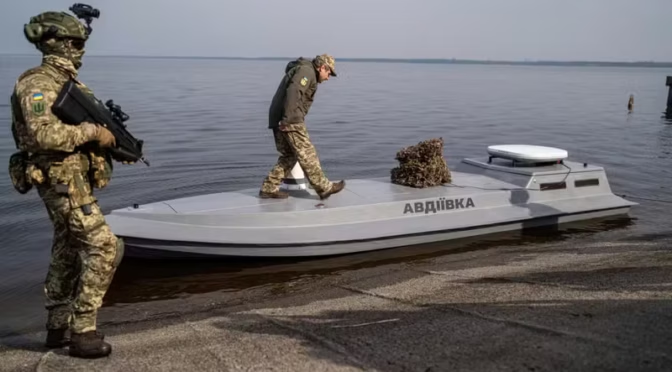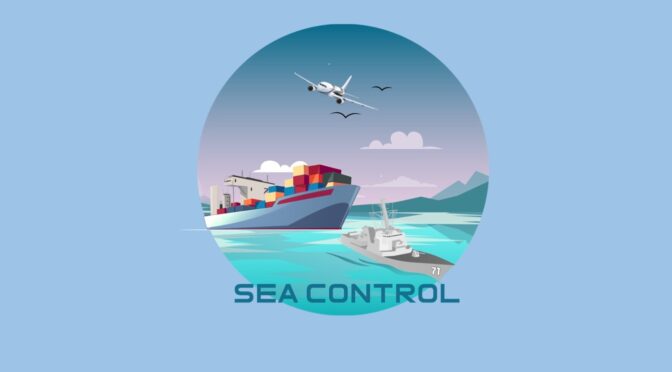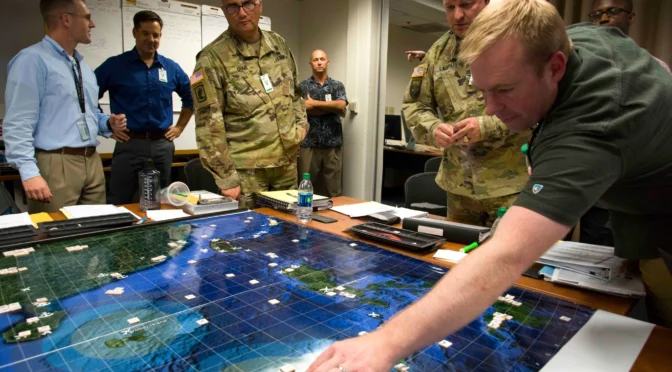By David Kirichenko
Russia’s full-scale invasion of Ukraine in 2022 shocked the international order. What surprised the world even more was Ukraine’s ability to resist. While many in the West believed Ukraine would only hold out for a few weeks, the war has now entered its fourth year. Ukraine has relied on agility and innovation – especially in its use of drones and battlefield technology – to fend off Russian forces. This technological edge has extended beyond land warfare to the sea.
Over the past few years, Ukraine’s growing use of naval drones has pushed both sides to rapidly adapt, accelerating the race for countermeasures and maritime innovation. NATO would do well to study Ukraine’s approach as it prepares for the future of warfare at sea. Rear Admiral James Parkin, the Royal Navy’s director of development, notes that in 28 maritime battles, the larger fleet won all but three. Parkin believed that larger fleets win, but Ukraine has changed that paradigm, for now. The future of naval warfare is here and Ukraine is demonstrating what the future looks like.
Valerii Zaluzhnyi, Ukraine’s former commander-in-chief and current ambassador to the U.K., stated, “I have repeated many times that the nature of modern warfare has changed and continues to change.” Zaluzhnyi added, “The nature of modern warfare is far from what NATO is now operating.”
Ukraine’s Naval Lessons
At the outset of the war, Ukraine’s navy was virtually nonexistent, having lost most of its fleet when Russia annexed Crimea in 2014. Its only major warship, the frigate Hetman Sahaidachny, was scuttled by Ukrainian forces in February 2022 to prevent its capture. Yet through asymmetric tactics – naval drones, coastal missile strikes, and aerial attacks – Ukraine has transformed the Black Sea battlefield, forcing Russia into retreat and reclaiming strategic control of key waters around Ukraine’s coast.
Serhii Kuzan, chair of the think tank Ukrainian Security and Cooperation Center and a former adviser to Ukraine’s Ministry of Defense, explained that even before the full-scale invasion, Ukraine understood it could not match Russia in conventional naval strength.1 As a result, it adopted an asymmetric strategy focused on coastal missile systems, small vessels, and air support. After 2022, sea drones were added to this concept and have since become the navy’s primary strike weapon at sea. These unmanned systems emerged out of necessity, filling the gap left by the absence of a traditional fleet.
Ukraine is now rebuilding its navy around a fleet of unmanned surface vehicles (USVs), making sea drones central to its maritime strategy. When Russia attempted to blockade Ukrainian shipping, Kyiv responded swiftly with sea drone strikes. Even after the Russian Navy retreated from occupied Crimea to the safety of its mainland ports, Ukrainian USVs continued to harass and damage its fleet.
Following the sea drone offensive in 2023, Former US Navy Admiral James George Stavridis noted, “We’re at a juncture in military evolution akin to the game-changers like Agincourt or Pearl Harbor. Expensive manned surface warships now face existential threats from affordable drones.” The Ukrainians issued a warning in August 2023 that “There are no more safe waters or peaceful harbors for you in the Black and Azov Seas.” The Russians eventually learned to heed that warning and hid from Ukraine’s sea drones. According to Roy Gardiner, an open source weapons researcher and former Canadian Armed Forces officer, “These asymmetric victories have forced the relocation of the Russian Fleet to the eastern Black Sea, and broke the blockade to reopen the vital grain export routes.”
Ukraine’s drones have even achieved the unprecedented. By January 2025, modified Magura V5 sea drones armed with heat-seeking missiles shot down two Russian Mi-8 helicopters and damaged a third off the coast of Crimea – marking the first time a naval drone successfully downed enemy aircraft. In May 2025, Ukraine stunned the world by using sea drones equipped with AIM-9 Sidewinder missiles, each worth about $300,000 to shoot down two Russian fighter jets, each worth $50 million. The Ukrainian sea drones themselves are worth only several hundred thousand dollars. HI Sutton, a naval warfare expert wrote, “The success of Ukraine’s uncrewed surface drones (USVs) cannot be overstated. They are rewriting the rules of naval warfare.”
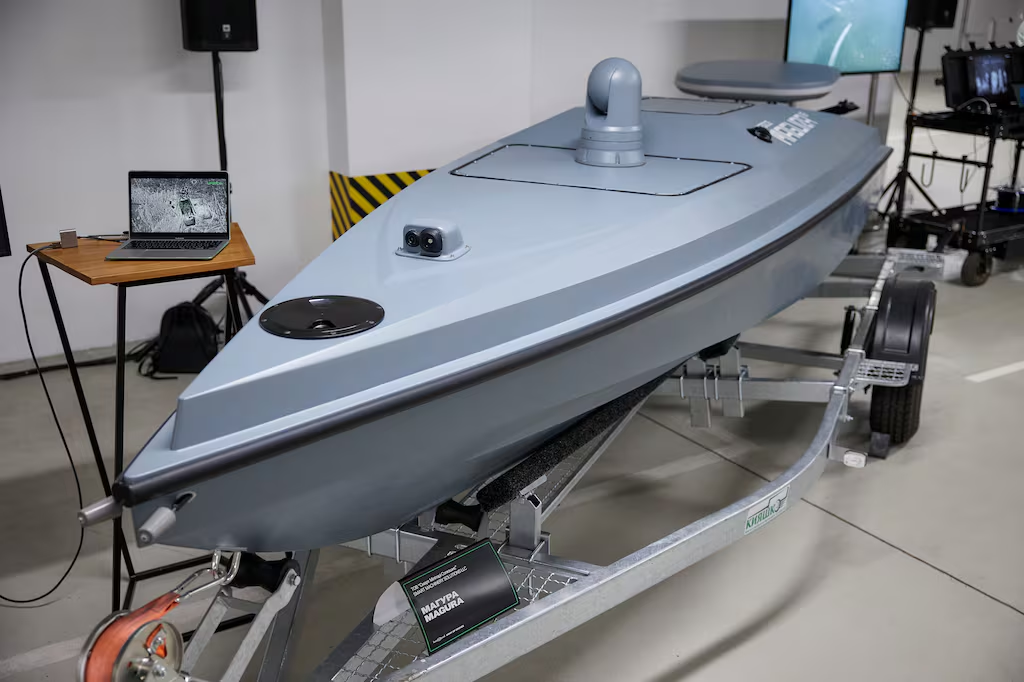
Ukrainian forces are increasingly adapting these drones for multi-role capabilities, equipping them with missile launchers and advanced payloads. Ukraine has effectively turned its USVs into robotic drone carriers capable of launching explosive FPV drones at Russian coastal targets. One of Ukraine’s latest sea drones, can launch up to four quadcopter First-Person View (FPV) drones and may carry naval mines, enabling complex multi-phase attacks. Ukrainian intelligence recently announced that their sea drones have been upgraded to carry over a ton of explosives and can now operate across distances exceeding 1,000 kilometers (about 621 miles), significantly expanding their strike range and lethality across the Black Sea. “We completely blocked the Russian Black Sea fleet in the water area near the port of Novorossiysk,” said Kyrylo Budanov, the head of Ukraine’s defense intelligence (HUR). He added that said the Russian fleet can no longer come out to the open waters.
“The cost of USVs such as Magura V5 and Sea Baby is about $250,000, which is inexpensive relative to their significant tactical and strategic success,” said Gardiner. “With naval targets gone from the western Black Sea, some Ukrainian USVs have transitioned to FPV carriers and launched successful attacks on multiple radars and air defense systems in Crimea.”
According to Kuzan, sea drones have emerged as one of Ukraine’s most effective tools against the Russian fleet. Ukrainian unmanned systems have struck Russian ships and boats 21 times, with 10 vessels confirmed destroyed and several others severely damaged. As a result, Russian naval forces have lost the initiative at sea and are now largely confined to operating near the ports of Sevastopol in occupied Crimea and Novorossiysk on the Russian mainland. Kuzan highlighted that these drone strikes have also enabled Ukraine to reopen the grain corridor despite Russia’s withdrawal from the agreement, effectively restoring maritime trade.
Despite Ukraine’s impressive string of successes at sea, Russia has begun mounting a more effective defense. According to Ukrainian Navy Commander Oleksiy Neizhpapa, Moscow has built a multi-layered system around key locations like Sevastopol Bay, including long-, medium-, and short-range detection zones designed to identify and destroy incoming sea drones. “In the past, we could easily enter Sevastopol Bay with our drones,” Neizhpapa said.
“Now it’s not so simple because the enemy has established a tiered defense system.” In response, Ukraine is working to upgrade its unmanned systems with more advanced weaponry and modular designs that can adapt to rapidly evolving threats. Russia has adapted but by bringing out its ships into the open sea, meaning that the success rate of Ukraine’s sea drones has also dropped. According to Gardiner, “Naval vessels have been equipped with thermal vision systems to better combat Ukrainian USV nighttime attacks.”
The naval drone war is also becoming more symmetric: Russian forces are beginning to deploy their own sea drones. “They are gearing up for it,” Neizhpapa warned, “so we are preparing not only to deploy drones against the enemy but also to defend against them.”
Gregory Falco, an autonomous systems and cybersecurity expert at Cornell University, commented on the design balance between sophistication and scale. According to Falco,
“The sea is a highly dynamic environment so it has been a more difficult domain to design robust and reliable systems for. Given Ukraine’s people-constrained navy, they have relied on unmanned systems which Ukraine has adeptly made cost efficiently and therefore largely disposable. The sophistication of this technology right now is less important than its scale and cost. Scale for drones is what will help win wars.”
The war in the Black Sea shows how asymmetric innovation can shift the balance of power. Despite having no traditional fleet, Ukraine has dealt major blows to a superior naval force using low-cost, adaptable technology. Dmitry Gorenburg, a researcher with the Center for Naval Analyses, remarked that,
“Russia has been forced to erect barriers for harbor protection, which have been relatively effective. But Ukraine showed that it could still damage Russian ships at sea. In the future, the cost asymmetry between cheap drones and expensive ships will mean that even a low success rate will prove highly damaging to naval forces, including Russia. The advantage of having a powerful navy will thus be somewhat decreased.”
However, Kuzan stresses that drones alone cannot provide full control over maritime space. A balanced navy remains essential. Looking ahead, Ukraine’s future fleet will likely combine Ada-class corvettes, missile boats, and coastal defense systems, with sea drones continuing to serve as the main offensive force.
Adaptability and Technology
Moreover, both China and Russia “are surging ahead in the realm of small drones, while the United States moves at a relatively glacial pace,” the Modern War Institute at West Point noted in a March 2024 report. Deborah Fairlamb, founding partner of Ukraine-focused venture capital firm Green Flag Ventures said, “I still believe that the West really does not understand how much warfare has changed.” Fairlamb pointed out the rapid technological advancements on the battlefield, increased mass production, and the decreasing cost of effective weaponry – such as $500 drones that can take out a $5m tank, a $30m radar system.”
Now, the U.S. Navy is embracing unmanned systems with urgency, spurred by lessons from Ukraine’s naval drone success and asymmetrical threats like the Houthis in the Red Sea. Ukraine is already working closely with artificial intelligence (AI) and is rapidly reshaping modern warfare, particularly through machine vision in drones and ground platforms, allowing for autonomous targeting. Ukraine is at the forefront of this transformation, with over 90 percent of AI military technologies coming from domestic developers, including swarming drone systems.
Ukraine is placing innovation at the heart of its defense strategy, leveraging homegrown technologies to stay ahead on the battlefield. Mykhailo Fedorov, the country’s minister of digital transformation, emphasized this approach in a speech at the The NATO-Ukraine Defense Innovators Forum:
“In Ukraine, we fight with innovations made in Ukraine. It is a constant work, a continuous R&D process, solving logistical problems with components and looking for solutions five steps ahead. Ukraine is already the best R&D center for any innovation. Today we get a technology for testing, and tomorrow we will scale it hundreds of times.”
Ukraine’s defense tech sector is accelerating rapidly under the pressure of war, driving battlefield innovation in drones, robotics, AI, electronic warfare, and demining systems. Platforms like the government-backed Brave1 fast-track promising technologies – by providing funding, testing, and streamlined certification, bypassing the slow procurement systems common in the West. “I always tell our American and other international partners: if your drone hasn’t been tested in Ukraine, it’s still just a toy,” said Oleksandra Ustinova, a Ukrainian member of parliament.
Economics of War
Modern warfare is now a battle of economics and scale, where the key metric is no longer troop numbers, but the cost and quantity of systems deployed. Cheap, one-way drones costing under $1,000 have become central to the fighting in Ukraine and elsewhere, capable of destroying far more expensive targets. As Christian Brose noted in The Kill Chain, U.S. military dominance has long relied on costly platforms like tanks, stealth fighters, and aircraft carriers. First-person view drones invert that model, using cheap, smart, networked machines to challenge the traditional military-industrial complex. As the U.S. continues to rely on high-cost systems, adversaries like China, Russia, and even non-state actors are leveraging mass-produced, inexpensive drones and missiles to inflict outsized damage at a fraction of the cost.
Andy Yakulis, a former Army special operations commander, highlighted how expensive the USS Gerald R. Ford aircraft carrier is at $13 billion, with other platforms, “such as the F-35, costing between $80m to $100m per aircraft. While the U.S. was building such systems, China has been focused on cheaper systems that, in mass, can destroy these large systems.” Yakulis further pointed out that in the Red Sea, the U.S. Navy has been using two $1 million missiles to shoot down Houthi drones that cost just $40,000 each. That means the cost of the drone is only about two percent of the price of the missiles needed to destroy it.
“Our adversaries use $10,000 one-way drones that we shoot down with $2 million missiles,” said Army Gen. Bryan P. Fenton. “That cost benefit curve is upside down.” The Houthis in under two months were also able to shoot down $200 million worth of U.S. drones in the Yemen conflict.
Taiwan is Taking Note
Taiwan has also recently unveiled its first uncrewed surface vessel (USV), the Endeavor Manta, developed specifically for naval defense in the Taiwan Strait. Built by CSBC Corporation, the vessel is designed for swarm operations, can carry light torpedoes and a warhead for kamikaze-style strikes, and includes autonomous navigation, AI target recognition, and anti-hijacking features. Inspired by Ukraine’s use of naval drones, the Manta is part of Taiwan’s broader strategy to counter Chinese military superiority through low-cost, asymmetric warfare, joining a growing global trend of using drones as force multipliers in modern conflicts. Alessio Patalano, Professor of War and Strategy at King’s College, London, noted that relying on weapons that are cheaper and easier to acquire will be critical to helping Taiwan defend itself against a potential Chinese invasion.
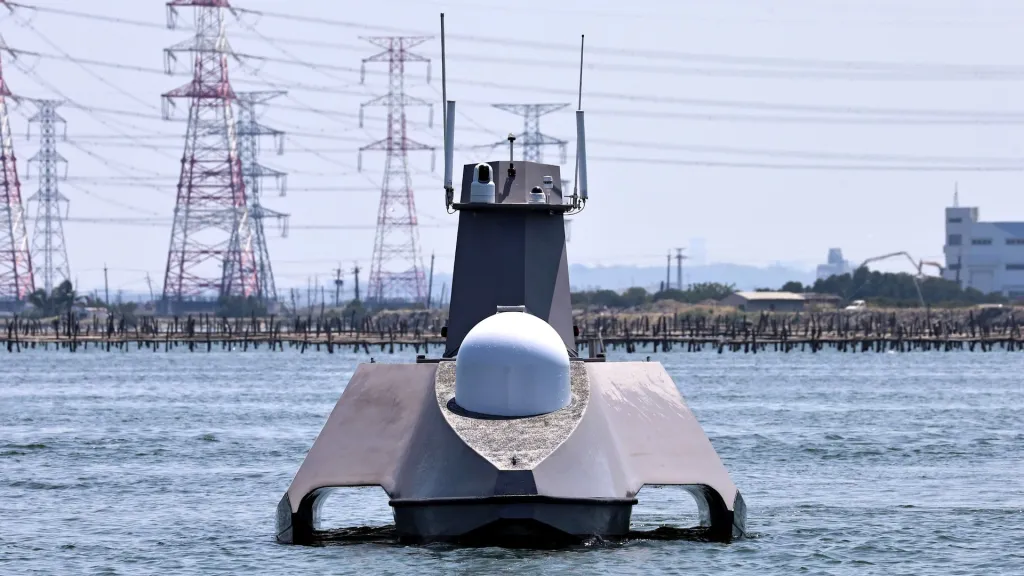
Rather than attempting to match China’s drone production, Hunter Keeley of the U.S. Marine Corps suggested Taiwan should adopt Ukraine’s targeted approach: deploying naval drones and missiles in focused, intelligence-led strikes near expected landing zones. A limited, layered Hellscape – centered on drones, jammers, and mobile sensors – could significantly disrupt PLA amphibious operations and buy Taiwan critical time in the opening stages of a conflict.
According to Kuzan, “Taiwan already benefits from U.S. support and has its own advanced defense industry, which is testing both surface and underwater maritime drones. For example, Taiwan’s Smart Dragon underwater drone is reportedly armed with torpedo systems.” He believes that incorporating torpedoes into Ukrainian sea drones could be the next step in their development. Kuzan remarked that, “If the opportunity and necessity arise, Ukraine could potentially sell or exchange its military technologies with Taiwan. This would be mutually beneficial, allowing both countries to enhance their capabilities.”
China and Russia Prepare
Russia is also taking notes. While it has significantly lagged behind Ukraine in naval drone warfare, it is now preparing for the future at sea. At the Army-2024 defense show, Russia unveiled the Murena-300S, a new naval drone resembling Ukraine’s successful sea drones. With a 500 km range, the fast and compact USV is built for coastal missions such as reconnaissance, mine-laying, and strike operations, possibly with a large explosive payload. The Murena appears to feature a Starlink antenna, suggesting Russia is seeking to match Ukraine’s real-time drone control capabilities.
The Russians have learned hard lessons from Ukraine’s asymmetric warfare and are now applying those insights more rapidly. Russia is creating unmanned systems regiments within its Navy that will integrate aerial, ground, and maritime drones to carry out reconnaissance and strike missions across all fleets. These new units, equipped with systems like Orlans, Lancets, FPVs, and USVs, are expected to form the backbone of the Navy’s unmanned component, with deployments planned across the European, Pacific, Caspian, and Dnieper naval forces.
At the same time, Russia is steadily advancing toward the development of AI-enabled autonomous drone swarms. It is investing heavily in AI research, both domestically and through partnerships with countries like Iran and China. Russia is focusing its efforts on leveraging cheap, scalable drone technology to overwhelm adversaries. This can be applied to the battle at sea as well. If the U.S. aims to deploy large expensive ships across the Asia-Pacific, we could see our adversaries working together to deploy cheap drones to destroy the ships.
China has also unveiled the Feiyi drone earlier this year, the world’s first known aerial and underwater drone capable of launching from a submarine, transitioning between air and sea multiple times, and returning to its original platform.
Preparing NATO for the Future
In a February 2025 interview, Anduril founder Palmer Luckey laid out bold ideas for revitalizing the U.S. defense industry and countering China’s growing military threat. He argued that the U.S. should shift from “world police” to “world’s gun store,” prioritizing mass production of weapons over elite, slow-to-build systems. Citing China’s massive manufacturing capacity and militarized civilian infrastructure, Luckey warned that Beijing is preparing for full-scale war, including repurposing commercial ships and producing cruise missiles far faster than the U.S.
Warfare is rapidly evolving into a battle of algorithms and adaptability. If the West clings to its old-school model of building massive, slow-to-deploy systems, it risks a harsh wake-up call – where billion-dollar warships are struck down by sea drones costing a fraction of that. In this new era, speed, scale, and software will determine who dominates the battlefield. When Russia invaded Ukraine in 2022, it was unprepared for how quickly warfare would evolve, and how drones would come to dominate the skies.
Now Ukraine has amassed a massive war-time video dataset, over 2 million hours of drone footage through its OCHI system, which collects and analyzes feeds from 15,000 frontline drone crews. This data is being used to train AI for battlefield applications such as target recognition, weapon effectiveness analysis, and autonomous drone tactics.
Kuzan believes that Ukraine is already working on building AI technologies for its sea drones as well. “Notably, during the successful maritime drone attack on December 31, 2024, which resulted in the destruction of Russian helicopters, many researchers speculated that AI was used to enhance target identification and missile guidance,” said Kuzan.
NATO should work closely with Ukraine on the development of these models to prepare its own autonomous sea drones to deploy them in future conflicts. The UK-built Kraken3, inspired by Ukraine’s battlefield innovations, was recently unveiled, showcasing AI-powered swarming capabilities, kamikaze drone launches, and GPS-free navigation, reflecting how Ukrainian success is already influencing NATO procurement.
NATO itself has begun expanding its unmanned maritime capabilities, recently demonstrating autonomous surface vessels in the Baltic Sea through Task Force X, an initiative designed to deter sabotage and fill surveillance gaps. But these sea drones are focused on addressing the threat of Russian sabotage. More practical drones are needed to help disable enemy warships, such as in the event of a Chinese blockade of Taiwan. Expensive systems will no longer do the job. Cheap and scalable solutions are what is needed for NATO. Some in the U.S. are already thinking about how naval warfare is being transformed. For example, the U.S.-based Anduril has unveiled the Seabed Sentry – a network of AI-powered mobile undersea sensor nodes designed for persistent monitoring and undersea kill chains.
Lithuania is leading by example as it is moving toward shared sea drone production with Ukraine under a “1+1” model, where one Magura-class sea drone would be retained for Lithuania’s defense and the other delivered to Ukraine. “Whether you want to believe it or not, whether you have or are about to sign contracts for tanks and helicopters for the next 10 years, the nature of military power has already changed,” said Zaluzhnyi.
Today, Ukraine’s sea drones control a significant extent of the Black Sea. In a future conflict over the Arctic or the Asia-Pacific, we can expect an even greater surge – a true sea of drones. As Ukraine’s navy chief put it, “After the war we will certainly write a textbook and we’ll send it to all the NATO military academies.”
David Kirichenko is an Associate Research Fellow at the Henry Jackson Society. His work on warfare has been featured in the Atlantic Council, Center for European Policy Analysis, and the Modern Warfare Institute, among many others. He can be found on X/Twitter @DVKirichenko.
References
1. This article draws on interviews conducted by the author from the period of March-April 2025.
Featured Image: A Ukrainian military counterintelligence brigadier general walks on a new Sea Baby “Avdiivka” naval drone, during its presentation by the Ukrainian security service, in the Kyiv region, on March 5, 2024. (Photo by Evgenniy Maloletka/AP)

